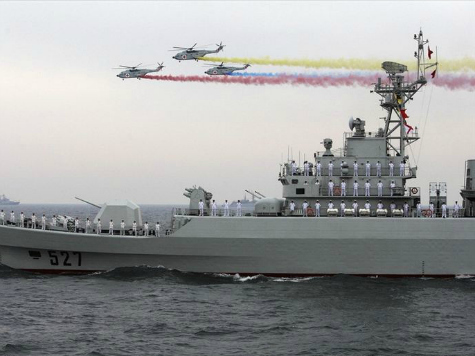
The South China Morning Post reported that China intends to build an artificial island base in the disputed and oil-rich Spratly Islands between the coast of Vietnam and the Philippines. With the U.S. fracking boom destroying China’s comparative advantage in manufacturing from cheap labor, Beijing is facing the loss of tens of millions of jobs. Facing a very serious threat, China appears to be moving militarily to claim virtually all energy resources in the East and South China Sea.
As much as 50% of global oil tanker shipments pass through the South China Sea, which sees three times more tanker traffic than the Suez Canal and more than five times that of the Panama Canal, making the waters one of the world’s busiest international sea lanes. A Chinese military fortress in the Spratly Islands with airport and docking facilities could dominate the South China Sea in a similar fashion as the United States’ military facility at Diego Garcia dominates the Indian Ocean sea lanes.
Energy averages 13.5% and labor averages 8.5% of input costs for basic manufacturing. From 1870 to 1970, the United States dominated world manufacturing and won two world wars through the comparative advantage of energy costs that were one third of world rates. But after 1970, the combination of the rise of abundant energy supplies from the Middle East and decline in U.S. production due to regulatory restrictions and an oil export ban destroyed the U.S. comparative advantage in manufacturing.
High American wage costs drove U.S. manufacturers off-shore to Japan and then later to China for cheap labor. But by 2008, a combination of currency appreciation and inflation eliminated Chinese labor cost comparative advantage to the United States. To continue to maintain 10% annual growth rates since the 2008 global financial crisis, Chinese industry borrowed an additional $15 trillion, equivalent to 22% of the world’s GDP.
During this period, the average cost of natural gas price in the U.S. fell from $11 a thousand cubic feet (mcf) in 2008 to about $4 today; compared to Asian rates that rose from $12 in 2008 to $17 today. The credit-fueled growth allowed China to take the crown as the world’s largest manufacturer in 2010, but China also became the world’s largest oil importer in early 2014.
Higher energy costs crushed China’s manufacturing competitiveness. Despite the China National Bureau of Statistics proclaiming 7.4% GDP growth in the 2014 January-March quarter, real GDP growth rate fell to -1% according to Lombard Street Research.
The overvaluation has also hurt corporate profits, which have been flat for two years. Corporate debt as a share of GDP surged 15 percentage points in that time, while corporate deposits have hardly changed. This suggests bank lending to companies is being used to pay interest on old loans rather than to expand production facilities.
Facing the political chaos of tens of millions of potential job losses, the People’s Bank of China began intervening in February to weaken the Chinese yuan currency in the hopes of regaining its cheap labor comparative advantage. But the yuan would have to fall by 25% to off-set China’s comparative disadvantage from higher energy costs. Although the central authorities probably have the muscle to enforce such direct pain on workers’ wages, the cost of imported energy would immediately inflate by an equivalent amount.
Newspaper reports of a new Spratly Islands base follow similar accounts in China’s official press late last month that said plans had been drawn up for constructing an artificial island on the Fiery Cross Reef. Those reports said that the project would cost $5 billion and take ten years and would ultimately produce a five-square-kilometer military base. The reports said that the strategic value of the base would “be equivalent to that for building an aircraft carrier.”
SCMP quoted Jin Canrong, a well-known professor of international relations at Renmin University, who said an artificial island would most likely be used in part to enforce Chinese sovereignty over a future Air Defense Identification Zone (ADIZ) in the South China Sea. He noted that in late 2013 China claimed sovereignty over an “enhanced” Air Defense Identification Zone (ADIZ) across almost the entire East China Sea.
China raised tensions in the South China Sea by sinking a Vietnamese fishing boat last week and recently placing an oil rig in mutually disputed waters. The Philippines has also accused China of building another artificial island on mutually disputed Johnson South Reef in the Spratly Islands. Having lost competitiveness and facing tens of millions of job losses, China seems intent on militarily taking control of the choke point for Asian energy imports and most off-shore energy resources in the Eastern Pacific.
The author welcomes feedback and will respond to comments by readers.

COMMENTS
Please let us know if you're having issues with commenting.